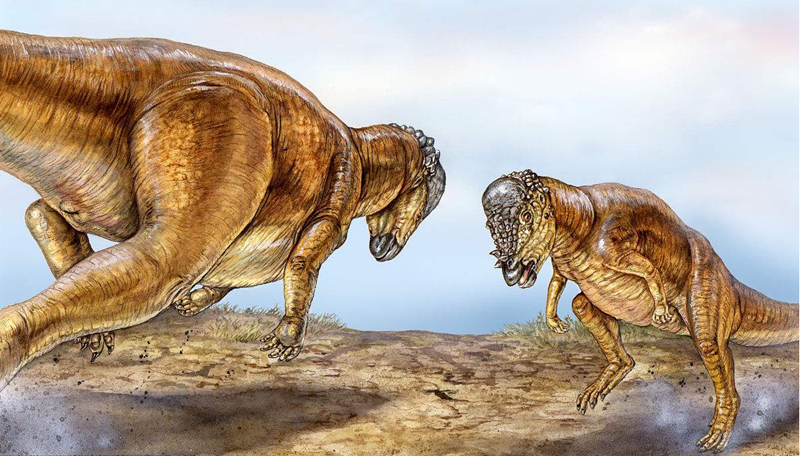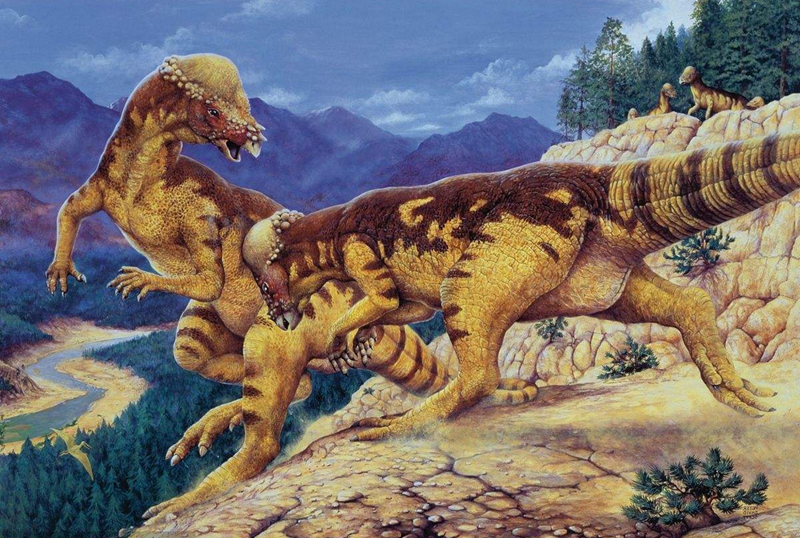Dinosaur Knowledge Tips Pachycephalosaurus
Release time:2017/10/30 15:27:00

Pachycephalosaurus (; meaning "thick-headed lizard," from Greek pachys-/παχυς- "thick", kephale/κεφαλη "head" and sauros/σαυρος "lizard") is a genus of pachycephalosaurid dinosaurs. The type species, P. wyomingensis, is the only known species. It lived during the Late Cretaceous Period (Maastrichtian stage) of what is now North America. Remains have been excavated in Montana, South Dakota, and Wyoming. It was an herbivorous creature which is primarily known from a single skull and a few extremely thick skull roofs, though more complete fossils have been found in recent years. Pachycephalosaurus was one of the last non-avian dinosaurs before the Cretaceous–Paleogene extinction event. Another dinosaur, Tylosteus of western North America, has been synonymized with Pachycephalosaurus.
Like other pachycephalosaurids, Pachycephalosaurus was a bipedal herbivore with an extremely thick skull roof. It possessed long hindlimbs and small forelimbs. Pachycephalosaurus is the largest known pachycephalosaur.
The thick skull domes of Pachycephalosaurus and related genera
gave rise to the hypothesis that pachycephalosaurs used their skulls in
intra-species combat. This hypothesis has been disputed in recent
years.

The anatomy of Pachycephalosaurus is poorly known, as only skull remains have been described. Pachycephalosaurus is famous for having a large, bony dome atop its skull, up to 25 cm
(10 in) thick, which safely cushioned its tiny brain. The dome's rear
aspect was edged with bony knobs and short bony spikes projected upwards
from the snout. The spikes were probably blunt, not sharp.
The skull was short, and possessed large, rounded eye sockets that
faced forward, suggesting that the animal had good vision and was
capable of binocular vision. Pachycephalosaurus had a small muzzle which ended in a pointed beak. The teeth were tiny,
with leaf-shaped crowns. The head was supported by an "S"- or "U"-shaped
neck.
Pachycephalosaurus was probably bipedal and was the largest of the pachycephalosaurid (bone-headed) dinosaurs. It has been estimated that Pachycephalosaurus was about 4.5 metres (14.8 ft) long and weighed about 450 kilograms (990 lb). Based on other pachycephalosaurids, it probably had a fairly short,
thick neck, short fore limbs, a bulky body, long hind legs and a heavy
tail, which was likely held rigid by ossified tendons.

It has been commonly hypothesized that Pachycephalosaurus and its relatives were the bipedal equivalents of bighorn sheep or musk oxen,
where male individuals would ram each other headlong, and that they
would horizontally straighten their head, neck, and body in order to
transmit stress during ramming. However, there have also been
alternative suggestions that the pachycephalosaurs could not have used
their domes in this way.
The primary argument that has been raised against head-butting is
that the skull roof may not have adequately sustained impact associated
with ramming, as well as a lack of definitive evidence of scars or other
damage on fossilized Pachycephalosaurus skulls (however, more recent analyses have uncovered such damage; see below). Furthermore, the cervical and anterior dorsal vertebrae show that the
neck was carried in an "S"- or "U"-shaped curve, rather than a straight
orientation, and thus unfit for transmitting stress from direct
head-butting. Lastly, the rounded shape of the skull would lessen the
contacted surface area during head-butting, resulting in glancing blows.
Alternatively, Pachycephalosaurus and other pachycephalosaurid
genera may have engaged in flank-butting during intraspecific combat.
In this scenario, an individual may have stood roughly parallel or faced
a rival directly, using intimidation displays to cow its rival. If
intimidation failed, the Pachycephalosaurus would bend its head
downward and to the side, striking the rival pachycephalosaur on its
flank. This hypothesis is supported by the relatively broad torso of
most pachycephalosaurs, which would have protected vital organs from
trauma. The flank-butting theory was first proposed by Sues in 1978, and
expanded upon by Ken Carpenter in 1997.
In 2012, a study showed that cranial pathologies in a P. wyomingensis specimen were likely due to agonistic behavior. It was also proposed that similar damage in other pachycephalosaur specimens previously explained as taphonomic artifacts and bone absorptions may instead have been due to such behavior. Peterson et al. (2013) studied cranial pathologies among the
Pachycephalosauridae and found that 22% of all domes examined had
lesions that are consistent with osteomyelitis,
an infection of the bone resulting from penetrating trauma, or trauma
to the tissue overlying the skull leading to an infection of the bone
tissue. This high rate of pathology lends more support to the hypothesis
that pachycephalosaurid domes were employed in intra-specific combat. Pachycephalosaurus wyomingensis specimen BMR P2001.4.5 was observed to have 23 lesions in its frontal bone and P. wyomingensis specimen DMNS 469 was observed to have 5 lesions. The frequency of
trauma was comparable across the different genera in the
pachycephalosaurid family,
despite the fact that these genera vary with respect to the size and
architecture of their domes, and fact that they existed during varying
geologic periods. These findings were in stark contrast with the results from analysis of
the relatively flat-headed pachycephalosaurids, where there was an
absence of pathology. This would support the hypothesis that these
individuals represent either females or juveniles, where intra-specific combat behavior is not expected.
Histological examination reveals that pachycephalosaurid domes are composed of a unique form of fibrolamellar bone which contains fibroblasts that play a critical role in wound healing, and are capable of rapidly depositing bone during remodeling. Peterson et al. (2013) concluded that taken together, the frequency of
lesion distribution and the bone structure of frontoparietal domes,
lends strong support to the hypothesis that pachycephalosaurids used
their unique cranial structures for agonistic behavior. CT scan comparisons of the skulls of Stegoceras validum, Prenocephale prenes, and several head-striking artiodactyls have also supported pachycephalosaurids as being well-equipped for head-butting.
Scientists do
not yet know what these dinosaurs ate. Having very small, ridged teeth
they could not have chewed tough, fibrous plants as effectively as other
dinosaurs of the same period. It is assumed that pachycephalosaurs
lived on a mixed diet of leaves, seeds, and fruits. The sharp, serrated
teeth would have been very effective for shredding plants.
from
Wikipedia